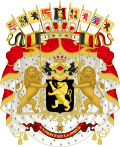Lions in heraldry
heraldic animal From Wikipedia, the free encyclopedia
Remove ads
Lions appear in heraldry more often than any other animal. It traditionally symbolises bravery, valour, strength, and royalty.
They may appear as a charge on the shield or as a crest. They are described in the blazon (heraldic description) by their tincture (color) and attitude (position). Sometimes the teeth and claws of a lion can be colored differently from the rest of its body; it is said to be "armed" of that color (e.g. "A lion Or armed gules" is a gold lion with red teeth and claws). Sometimes the tail is even described, if it is shown in an unusual way. One reason why lions are shown in so many different ways is because when heraldry developed, a lot of people wanted a lion on their coat of arms, but no two coats of arms can be the same. The purpose of heraldry in the Middle Ages was to identify people with bold images over the outside of their armour. Since a lot of people started putting lions on their coats of arms, they placed them in a lot of different positions and in every color used in heraldry. In France and Germany, they even made patterns of colors on some of their lions, as if they were painted.
French heralds refer to lions in the walking positions as leopards, but this term is seldom used by British heralds.[1]
Remove ads
Attitudes
Although there are many attitudes or positions now used in heraldry, very few of these were known to medieval heralds, who simply wanted to draw a lion to fill the space provided on the shield.[1] The following table describes the different attitudes of heraldic lions:
Other terms are used to describe the lion's position in further detail. The lion's head is normally seen in agreement with the overall position, (facing left) unless otherwise stated. If a lion's whole body is turned to face right, he is to sinister or contourné. If his whole body faces the viewer, he is affronté. If his head only faces the viewer he is guardant or gardant, and if he looks back over his shoulder (body facing left but head turned to face right) he is regardant. These words follow the main description of position, and then the lion is further described as armed (teeth and claws) of another color, if another color is used. And finally, the tail may be described if it is unusual. A lion (or other beast) coward carries its tail between its hind legs.[9] The tail also may be nowed (knotted), or the lion may be queue fourchée (forked tail) or double-queued (two tails).
 |
 |
 |
 |
 |
 |
| Lion guardant | Lion regardant | Lion coward | Tail nowed | Queue fourchée | Double-queued |
Remove ads
Examples
- Coat of arms of Persia (Qajar dynasty)
Related pages
Notes
References
Wikiwand - on
Seamless Wikipedia browsing. On steroids.
Remove ads













